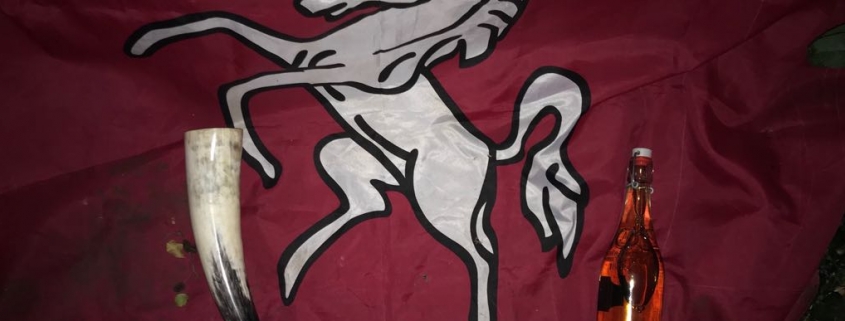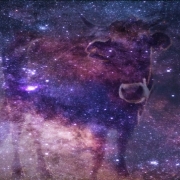Exploring the Blot – Part 1
By Mark Puryear
First published in ORB 207, Yule 2257
The word “blot” is an Old Norse term designating a sacrifice or offering. It is etymologically linked to English “blood”, which was its original meaning; since in ancient times animal and even human sacrifices were performed to the Gods and Goddesses, with their blood being a central object of observance. This may be shocking to some, but what many should know is that every race in every land on earth has practiced some form of blood sacrifice at one time or another, even the Hebrews. In fact, it has been surmised that the Jesus myth was created as a response to the Romans’ shock at the so-called “scapegoat” ritual practice celebrated annually in Israel. Here a victim was chosen to die to appease their god and cleanse them of that year’s sins, and in the earlier rites the flesh and blood of the individual was actually consumed. Christ acted as the eternal scapegoat, so such a ceremony would not need to be practiced again, although the Romans were not long past their human sacrifice phase themselves.
Even today, the idea of religious martyrdom is praised and zealously defended by practitioners of mainstream religions, and it is this mentality that was the drive behind killing people as a part of worship. The victim gave their life to their deity or deities, and many times to their folk, since these were often chosen when tribes had too many mouths to feed, or when a loved one chose to travel with the deceased in funerary rites. Other times, criminals or prisoners of war were used, and, minus the religious overtones, such practices continue in many countries to this day.
We recognize the slaying of people in ritual as a part of our archaic past, which, by the way, was beginning to become outdated even before the coming of Christianity. We still use the word “blot”, because this is the ancestral designation that came to mean any form of offering, even if no blood is ever spilt. Sometimes we may choose to slaughter an animal, which would be similar to modern Jewish koshering techniques, where we bless the food we are going to eat before its preparation. The blood of the animal is sprinkled upon the altar to bless it with the life-force of the creature that gave its life for our sacred purposes. It can also be used to bless the folk during the ceremony, since it is the blood that is the essence of existence, and is the gift of the Gods to all that lives.
All parts of the animal must be used, and its bones must not be broken. This is seen in the tale of Thjalfi, when he breaks the leg-bone of one of Thor’s goats at Loki’s instigation to suck the marrow, and incurs the wrath of the Asa-god (Hymiskvida 37-8, Gylfaginning 44). To this should be compared a sacrificial formula found in the Hindu text Atharvaveda (IX,5), which says:”He (who sacrifices a goat) shall not break his bones, he shall not suck out the marrow, he shall take the whole bone and contribute to him piece by piece, because this is his [the goat’s] figure and his figure he[the sacrificer] provides to him[the goat] again.” It should also be remembered that these sacrificial meals are always boiled, since Grimnismal 42 tells us that “the dwelling will be open to the Aesir’s sons when the kettles are lifted off”.
Of course, the most sacred offering known in our faith is that of the mead. Even the Vedic Hindus saw the Soma-Madhu (Soma-Mead) as the sacrifice with the greatest value. In the lore, there are several types of mead, all originating from the three Underworld mead fountains. Our mead comes from Natt and her horse Hrimfaxi, as well as the steeds of the Valkyries. These horses chew the leaves of Yggdrasil, then fly across the sky, when the froth from their bit “drops the dew in the dales” (Vafthrudismal 14, Helgakvida Hjorvarthssonar 28). “People call the dew, which falls to the earth, honey dew, and bees feed on it”(Gylfaginning 16). From this, honey is made, which is what we make our mead of.
When we consider the symbology of the stories handed down to us, it should be seen that the meals that the Gods partake in represent the sacrifices offered to them, which is part of their sustenance. When Grimnismal 19 says that Odin lives on “wine alone”, it means that the mead sacrifice is the only one sent to him, and when one chooses to offer him food, it will be used to feed his wolves, Freki and Geri. When Thor is described as the greatest mead-drinker, this has a relationship to blotar in his name. With his ravenous appetite, Thor can be honored with any sort of offering, and it is believed that his belt of strength was a later development to curb the requirement for such abundant sacrifices in his honor. His Hindu counterpart, Indra, is said in Rigveda (I: 8.7) to “drink the deepest draughts if soma, like an ocean swells”, which follows with “his gifts are so lovely; let lauds and praises be sung to Indra, so that he may drink the soma juice” (v. 10). This should be compared to Thor’s adventure at Utgardaloki’s, where he drank so much from a horn, whose end was connected to the ocean, that he caused the waters to lower and created the tides (Gylfaginning 46-47).
All of the Gods and Goddesses partake in the sumble, or mead-feast (see f. ex., Aegir’s feast in Lokasenna), which means that this holy drink can suffice as a proper offering in any ceremony. Groa and Idun share a common name, which reflects the importance of the mead in sacrifice; the name being Olgefn or Olgefjun, meaning “Ale-giver” (Haustlaung 11, 20). Skaldskaparmal 17 mentions Freyja serving mead to the giant Hrungnir “as if at the Aesir’s banquet”, and the Valkyries serve the mead in Valhalla. “They bring drink and see to the table and the ale cups” (Gylfaginning 36). That in all such cases we see the Gods and Goddesses consuming mead, along with our ancestors, shows that this is, by far, the holiest substance one can use in the blot.
From the Sagas and histories handed down to us it can be concluded that these gifts can actually be sent in four different ways, corresponding to the four elements. In each case, a portion of the offering is given to the Gods, while the rest is enjoyed by the gathered folk. For the element of air, there is the practice of leaving the sacrifice out, with the mead in a bowl and food on a plate. The idea here is that the Gods will come in the form of wild animals to partake in the meal left for them. For the element of earth, there is burial of food and libation of liquids, believing that returning these to the earth, to Frigga-Jord, strengthens all the gods and goddesses. Libation and drowning in a sacred body of water chosen by the folk sends the gifts to the divine realms through Hvergelmir, the holy fountain that revolves all waters throughout the worlds. Fire, solemnized by Heimdall himself, sends the offering to the gods in its smoke and rising flame, and is most pure when it is consecrated and kindled from the Naudeldr (Need-fire), the friction-fire made from rubbing wood together. Because of this, Heimdall was viewed as the one who carries the offerings to the Gods, as his Hindu counterpart, Agni, does the same (Rigveda I:128.6).
But what exactly does it mean to “offer” something to our deities? First off, it should be noted that our ancestors did not view oblations as marks of humility or penance before the divine, although they could be used to appease them. These gifts are given to the Gods to empower them, which is why these are described as their sustenance in the lore. In this manner, they can even sacrifice to one another, which is why Voluspa str. 7 explains that, in time’s morning, they built altars and temples to each other. Just as we can empower them with our offerings, they can do the same among themselves. In recognition of the “gift for gift” tradition Odin gave us in Havamal (see, for instance, strophe 42), the Hods answer our prayers in return for the blotar we perform. Because Odin understands human nature, and the bond we humans have with the divine, he asks us to not violate this relationship with too many offerings:
“It is better not to pray
Than offer too much;
A gift ever looks for a return.
It is better not to send
Than sacrifice too much.
So Thund (Odin) risted
Before the origin of men,
This he proclaimed
After he came home”.
-Havamal 146
This compared to a statement in Saxo’s History of the Danes bk. 1, where a certain Mitothin “asserted that the gods’ wrath and the profanation of their divine authority could not be expiated by confused and jumbled sacrifices; so he arranged that they should not be prayed to as a group, but separate offerings be made to each deity. When Odin returned, the other no longer resorted to his conjuring (…)”.
Thus, it is seen that fewer rites involving more deities are preferred by Odin himself.
We offer the gifts at the blotar to strengthen our Gods and Goddesses so they may perform their divine feats in the service of the worlds. Thus, they need us as much as we need them, making our relationship with them synergetic and reciprocal. We are their children, in blood and in our devotion to them, and our means of honoring them reflects this, which makes for a very profound spiritual experience.
It is this spiritual experience that uplifts us and empowers us, as it does our deities. It is incredibly special for us to know that we have something to bring to the table when praying to the Gods, rather than simply submitting to them as divine authoritarians who need nothing from us other than our compliance. Whether you believe they are physical or ethereal, archetypes or personifications of natural forces, we are all seeking that link to something greater than ourselves. And this is where the true core of the validity of blotar lies. It may be that our coming together as a folk is the sole provider of this spirituality, or that we actually are forging a bond with these higher beings from far-off realms. When we call to the heavens with all our hearts, it is our connection to the past and to the future that makes this such a powerful aspect of our lives.


 Hengest Thorsson
Hengest Thorsson
